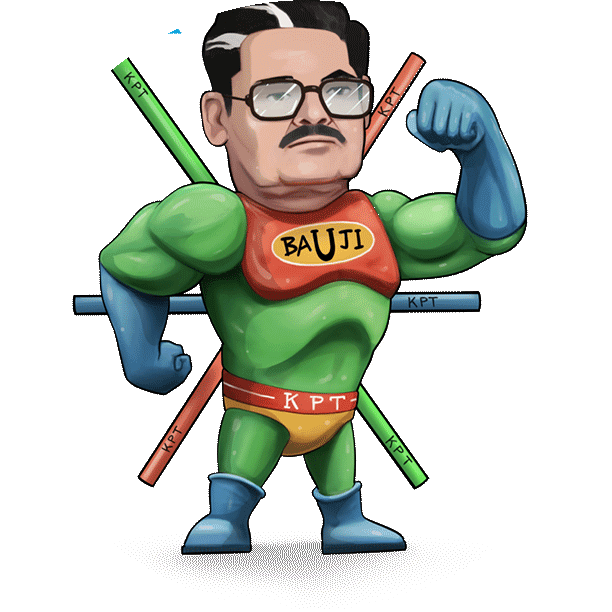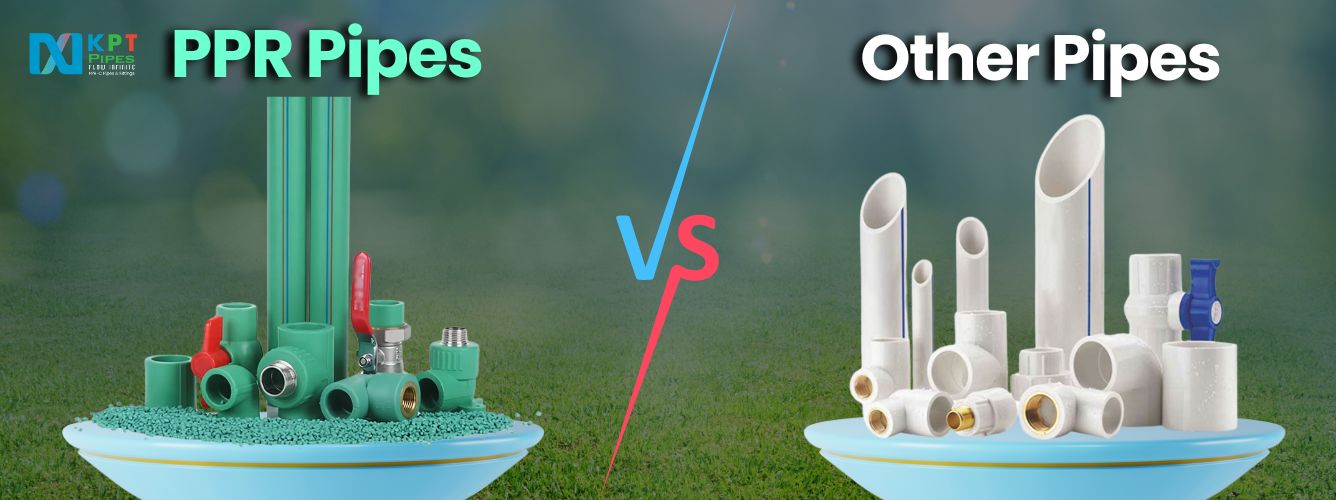In the world of plumbing, selecting the right type of pipe is crucial for ensuring the efficiency, durability, and safety of water distribution systems. PPR pipes have become increasingly popular because of their distinct properties and benefits. This article provides a comprehensive comparison between PPR pipes and other commonly used pipes, including PVC, CPVC, copper, and galvanized steel pipes.
Table of Contents
ToggleComparison with Other Pipes:
PPR Pipes vs PVC Pipes
When comparing PPR (Polypropylene Random Copolymer) pipes to PVC (Polyvinyl Chloride) pipes, several key differences emerge:
Material Composition:
- PPR: Made from Polypropylene Random Copolymer, known for its high resistance to pressure and temperature.
- PVC: Composed of Polyvinyl Chloride, offers an affordable drainage solution.
Thermal Resistance:
- PPR: Capable of withstanding temperatures from -5℃ up to 95°C, making them suitable for both hot and cold water applications.
- PVC: Primarily used for cold water systems due to lower thermal resistance compared to PPR.
Durability and Longevity:
- PPR: Highly resistant to corrosion, scaling, and chemical reactions, ensuring a long lifespan.
- PVC: Susceptible to degradation from prolonged exposure to sunlight and impact damage.
Installation Methods:
- PPR: Employs fusion welding to produce seamless and leak-proof joints, thereby improving dependability.
- PVC: Relies on solvent cement joints, which do not provide the same level of durability as fusion welding.
Cost-Effectiveness:
- PPR: Generally cost-effective due to lower maintenance requirements and extended lifespan compared to PVC.
- PVC: Initially cheaper than PPR, but may incur higher maintenance costs over time due to potential issues with durability and longevity.
PPR Pipes vs CPVC Pipes
When comparing PPR (Polypropylene Random Copolymer) pipes to CPVC (Chlorinated Polyvinyl Chloride) pipes, several key points emerge:
Material Composition:
- PPR: Made from Polypropylene Random Copolymer, known for its high resistance to corrosion and chemical reactions.
- CPVC: Composed of Chlorinated Polyvinyl Chloride, featuring added chlorine for enhanced heat resistance.
Thermal Resistance:
- PPR: Capable of withstanding temperatures from -5℃ up to 95°C, rendering them suitable for both hot and cold water uses.
- CPVC: Can withstand peak temperatures up to 90°C, suitable for hot water systems but lower than PPR.
Durability and Longevity:
- PPR: Highly durable, with excellent resistance to scaling and long-term chemical degradation, ensuring a prolonged lifespan.
- CPVC: Resistant to corrosion and chemical reactions, though prolonged exposure to certain chemicals may affect longevity.
Installation Methods:
- PPR: Employs fusion welding to create seamless and leak-proof connections at joints.
- CPVC: Relies on solvent cement joints, which do not provide the same level of durability as fusion welding.
Cost-Effectiveness:
- PPR: Typically economical because of reduced maintenance needs and durability, resulting in cost savings in the long run.
- CPVC: Moderately priced, with initial costs higher than PVC but has lower lifespan compared to PPR resulting in replacement cost over the long term.
PPR Pipes vs Copper Pipes
Material Composition:
- PPR: PPR pipes are made from Polypropylene Random Copolymer, a type of thermoplastic known for its high resistance to corrosion and chemicals.
- Copper: Copper pipes are crafted from metal, renowned for its excellent thermal conductivity and traditional aesthetic appeal.
Thermal Resistance:
- PPR: PPR pipes can withstand temperatures up to 95°C, making them ideal for both hot and cold water systems without compromising durability.
- Copper: Because copper pipes conduct heat efficiently, they are perfect for controlling the temperature in hot and cold water systems.
Durability and Longevity:
- PPR: Resistant to scaling, corrosion, and chemical degradation, PPR pipes offer a long lifespan and minimal maintenance requirements.
- Copper: Known for its resilience against high pressures and external damage, copper pipes can last decades without degradation.
Installation Methods:
- PPR: PPR pipes utilize fusion welding for jointing, ensuring seamless connections that are leak-proof and durable over time.
- Copper: Copper pipes require soldering techniques for jointing, necessitating skilled labor and potentially increasing installation time and costs.
Cost-Effectiveness:
- PPR: PPR pipes are highly cost-efficient when compared to Copper pipes.
- Copper: Costs for copper pipes are much higher due to material expenses and labor-intensive installation, therefore, they are used in very limited applications.
PPR Pipes vs Galvanized Steel Pipes
When comparing PPR (Polypropylene Random Copolymer) pipes to Galvanized Steel pipes, several key differences emerge:
Material Composition:
- PPR Pipes: Made from Polypropylene Random Copolymer, a durable thermoplastic known for its resistance to corrosion and chemicals.
- Galvanized Steel Pipes: Consist of steel pipes coated with a layer of zinc to prevent rust and corrosion, but susceptible to eventual rusting over time.
Thermal Resistance:
- PPR Pipes: Can withstand temperatures up to 95°C, making them suitable for both hot and cold water applications without compromising durability.
- Galvanized Steel Pipes: While capable of handling high temperatures, they are less efficient for hot water systems due to potential corrosion risks and reduced thermal efficiency.
Durability and Longevity:
- PPR Pipes: Highly durable, resistant to scaling, corrosion, and chemical reactions, ensuring a long lifespan with minimal maintenance requirements.
- Galvanized Steel Pipes: Initially robust, but over time, the zinc coating can wear off, leading to rust and reduced lifespan, especially in aggressive water conditions.
Installation Methods:
- PPR Pipes: Installed using fusion welding techniques, creating seamless joints that are leak-proof and reliable.
- Galvanized Steel Pipes: Requires threading and fittings for installation, which can be labor-intensive and prone to leaks if not properly sealed.
Cost-Effectiveness:
- PPR Pipes: PPR pipes are highly cost-efficient when compared to Galvanized Steel Pipes.
- Galvanized Steel Pipes: Galvanized steel pipes have higher initial cost and also requires regular maintenance which leads to excess costs in the long run.
PPR Pipes vs PEX Pipes
When evaluating PPR pipes vs PEX pipes, there are numerous important aspects to take into account.
Material Composition:
- PPR Pipes: Made from a type of thermoplastic known for its high temperature resistance and durability.It is commonly utilized for plumbing systems that handle both hot and cold water.
- PEX Pipes (Polyethylene): Also a thermoplastic, but with added cross-linking which enhances its flexibility, durability, and resistance to chemicals and temperatures.
Installation Method:
- PPR Pipes: Usually placed via heat fusion welding, which creates a strong, impermeable bond.
- PEX Pipes: Installed using compression fittings or crimped fittings, which are easier and quicker to install compared to PPR pipes.
Flexibility and Bending Radius:
- PPR Pipes: Generally less flexible compared to PEX pipes, with a larger minimum bending radius requirement.
- PEX Pipes: Extremely versatile, making installation easier around curves and in small spaces.
Application Suitability:
- PPR Pipes: Suitable for hot and cold water applications, providing excellent chemical resistance and durability.
- PEX Pipes: Particularly suited for residential plumbing due to limited size availability.
Cost Considerations:
- PPR Pipes: PPR Pipes are highly cost effective in terms of material cost and ensure long term savings with minimal maintenance.
- PEX Pipes: PEX Pipes are generally twice more expensive than PPR Pipe and therefore even with faster installation, it does not offset the initial material cost.
Longevity and Maintenance:
- Both PPR and PEX pipes are known for their durability and resistance to corrosion and scaling and ensures long term durability.
Conclusion
PPR pipes offer several advantages over other types of pipes, including superior thermal resistance, durability, eco-friendliness, and cost-effectiveness. Whether you are planning a residential plumbing project or an industrial piping system, understanding the benefits and limitations of each type of pipe is essential for making an informed decision. With their numerous benefits, PPR pipes are a reliable and efficient choice for modern plumbing systems.
FAQs
Q1.How do PPR pipes differ from CPVC pipes in terms of application and durability?
Ans: PPR pipes provide better chemical resistance and a longer lifespan than CPVC pipes, making them perfect for use in both hot and cold water systems. Contrarily, CPVC pipes are made especially for water systems and need to be fitted carefully to prevent breaking.
Q2.In what ways are PPR pipes superior to Copper pipes for plumbing installations?
Ans:PPR pipes are corrosion-resistant, lightweight, and easier to install than copper pipes. While copper is durable and has been traditionally used, PPR pipes offer better resistance to scale buildup and do not require soldering, making them more convenient for modern plumbing.
Q3. In terms of advantages, how do PPR pipes compare to galvanized steel pipes?Ans: PPR pipes are non-corrosive, which eliminates the risk of rust and scale formation common in galvanized steel pipes. They are also lighter and easier to install without the need for threading and welding, making them a preferred choice for many plumbing applications.
Q4.How do PPR pipes compare with PEX pipes in terms of flexibility and installation?
Ans: PPR pipes are rigid and installed using heat fusion welding, ensuring leak-proof joints and long-term reliability. PEX pipes, on the other hand, are highly flexible and can be installed quickly using compression fittings, making them ideal for renovations and tight spaces.
Q5.What are the considerations for choosing PPR pipes over PEX pipes in terms of long-term durability and maintenance?
Ans: PPR pipes are generally considered more durable and resistant to degradation over time compared to PEX pipes, which can be affected by exposure to UV light and chlorine. PPR pipes require minimal maintenance and are less prone to brittleness or cracking.



